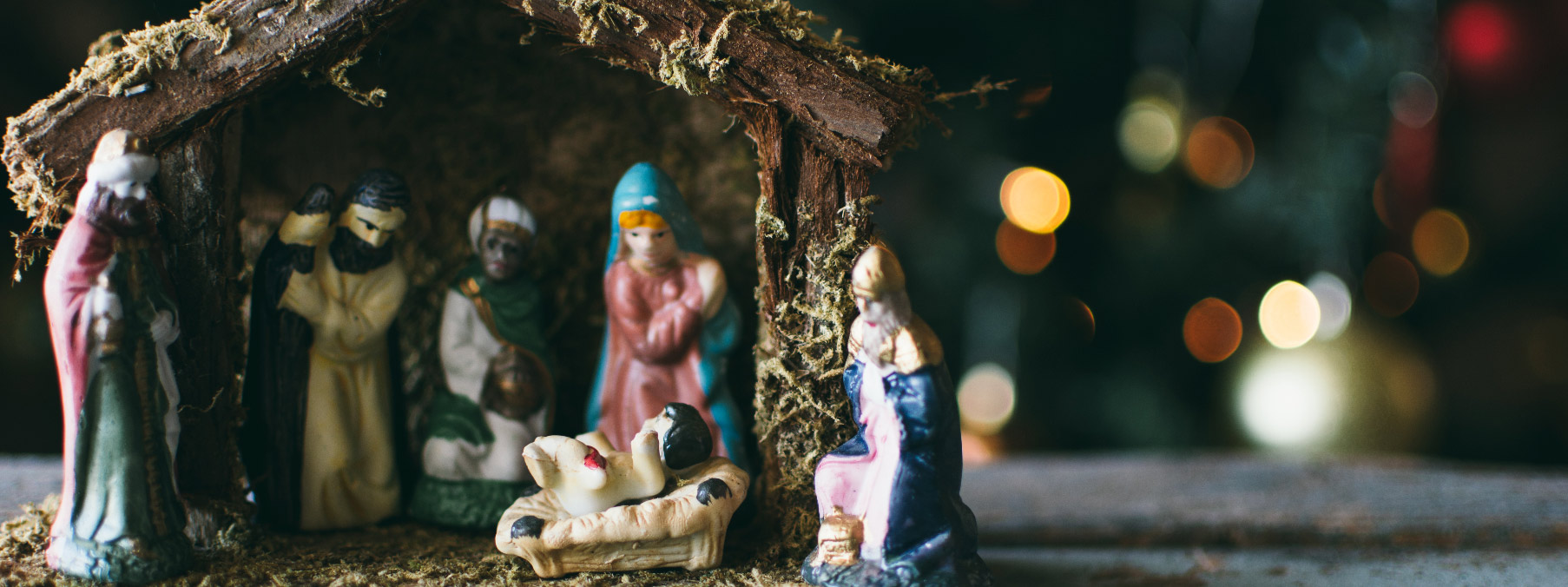

The ephemeral Catalan art of nativity scenes
The Christmas holidays are upon us and all over Catalonia we can find nativity scenes, living, plastic expressions of the birth of Jesus. These representations also continue to be installed in many homes, whether by cultural tradition or by faith. According to Catalan tradition, the nativity scene was set up on the 6th (Saint Nicholas), the 8th (La Puríssima) or the 13th (Santa Llúcia) until the 2nd of February (La Candelera).
Setting up the nativity scene is a centuries-old tradition. There are families who treasure the figures, which have been passed down from generation to generation, and who, as Christmas approaches, stroll around markets and fairs with the aim of discovering some new element. For many families, setting up the nativity scene becomes a shared and festive activity: it is a prelude to all the Christmas activities that await them.
However, in Catalonia and in other parts of the world, there is the figure of the ‘pessebrista’, the artisan who creates nativity scenes as an artistic activity. The ‘pessebrista’ is a multidisciplinary artist who, a couple of months before Christmas, starts working on the diorama or nativity scene he or she wants to exhibit. Nativity scenes are considered an ephemeral art, since every year, once the Christmas season is over, it is customary to destroy the work.
A tradition with 800 years of history
According to the etymological dictionary, the word ‘pessebre’ [crib] comes from the Latin word ‘praesepium’, which means stable or place where animals are kept. According to Christian tradition, Jesus was born in a stable, which is why in Catalan this word is used to refer to the representation. In Spanish, on the other hand, the name of the Palestinian town, Bethlehem, where Jesus is said to have been born, is used.
According to legend, Francis of Assisi (1182-1226) made the first nativity scene on Christmas Eve 1223, in a cave in the town of Greccio (Italy). With a live ox and a mule and a feeding trough full of straw, he represented the birth of Jesus to the neighbours he had invited. From then on, representing the birth of Jesus, by means of living nativity scenes or with sculptural figures, in convents, churches and, later, in private homes, became a tradition. The nativity scene came from Italy to Catalonia in the 18th century and has become the most widespread spiritual, cultural and traditional ephemeral art in our community.
In Catalonia there is a long tradition of nativity scenes. Despite the fact that this artistic hobby has fewer and fewer followers, the nativity scene movement is still very much alive. Without going any further, in 2018 the Museu del Pessebre de Catalunya was inaugurated, located in the medieval village of Montblanc. In 1985 the Federació Catalana de Pessebristes was created, with 66 associations in Catalonia and the Balearic Islands and 17,000 members. And since 1969 an annual meeting of artisans has been held, at which the federation and the associations organise courses, talks and meetings.
Moreover, the Catalan nativity scene movement is so strong that in 1952 it set up in Barcelona the only international federation of nativity scenes, the Universalis Foederatio Praesepistica (UN-FOE-PRAE), of which 20 nativity scene organisations from Europe, the United States, Argentina and Brazil are currently members. The Catalan artisans are recognised throughout the world thanks to the fact that they introduced plaster as a building material at the beginning of the 20th century. On the other hand, Catalonia has had and still has world-renowned sculptors of nativity scene figures.
The art of sculpting Jesus’ birth
The work of the nativity scene artisans is truly a work of art. Ismael Porta, the director of the Museu del Pessebre de Catalunya, explains that making a nativity scene takes between two and three months of work. “It depends on the size and details you want to put in. Because creating a handcrafted nativity scene is not a job that takes up a few hours of a Sunday afternoon, but requires hours of planning and construction,” he says.
For Porta, so many hours of dedication means that it is difficult to find a generational replacement. “Young people would rather spend their leisure time doing other things than spending two months building a nativity scene,” he laments. In addition to the hours of dedication, it is also necessary for the ‘pessebrista’ to have knowledge of different disciplines, and this is not always easy to find. “An artisan has to have artistic knowledge: drawing, perspective, lighting, landscaping, painting, mechanics? It all depends on the sophistication of the diorama,” the expert says.
Because a diorama depicts a scene from a particular moment in the life of the people, the central theme of which is the life of Jesus. Therefore, the interior of a house, the streets and the natural landscape can be seen in the diorama. The representations, like the figures, have two themes: the Hebrew, which represents the land where Jesus was born; and the popular, which represents the daily life of the Catalan people. Thus, we can find nativity scenes with figures dressed in sashes, ‘barretina’ [a typical Catalan hat], aprons and headscarves, or in oriental-style clothing.
The materials used to make a diorama are cork, cardboard, moss, polyethylene and plaster, among others. The Catalans were the first to introduce plaster into the nativity scene, a fact that revolutionised the world of nativity scenes and was soon imitated. And in recent years, polyethylene has been introduced. “Polyethylene is used quite a lot, because it is a lighter material, which allows larger constructions to be made, but it is less manageable. Gypsum is easier to work with, because it gives you more options. On the other hand, it weighs more,” Porta explains. It should be borne in mind that the base of a diorama can be between a metre and a metre and a half long, and transporting it is complicated when it weighs a lot.
However, the cost of the crib is not very high. “It doesn’t represent a very high investment in material, since a sack of plaster is cheap and polyethylene is usually reused, as we are used to collect remains of buildings under construction,” Porta argues. And he adds: “It all depends on what you want to spend. If you want to put in a motor to make water run or make the wind blow, the lighting… Without a doubt, the most expensive thing, if you want the crib to look good, is the figures.”
The artisan designs and builds a landscape, makes streets, houses, adds vegetation, lighting and fills it with characters. Figures made of clay, plastic, even Playmobil. “Sometimes you come across dioramas that are real works of art. Even so, they are spoiled by the figures that have been placed. The figures are a world apart,” Porta says. The expert regrets that there are fewer and fewer figurine craftsmen. “In Barcelona there are few figure workshops left. One of the best known, the workshop of the Castells brothers, who are the third generation, will have to close because they have no generational replacement.”
Porta explains that many artisans create their own figures, as is his case and that of another Montblanc nativity scene maker. Both go to Barcelona every Thursday to learn how to make figures with the Castells brothers. “Given the fact that there are fewer and fewer artisans of figures, we reached an agreement with them and they have been teaching us how to make figures for four years now.”
A profession that depends on voluntary work
Although it seems that the world of nativity scenes is in recess, because it is difficult to find a new generation, it is a living world thanks to the artisans who feel the need to share the ephemeral work of art that they make every year. A clear example of this voluntarism is the Museu del Pessebre de Catalunya, which works thanks to the impulse of the Associació de Pessebristes de Montblanc with the collaboration of the Federació Catalana de Pessebristes.
It must also be said that this completely masculinised world already has its first female artists. Moreover, thanks to the numerous exhibitions that we can visit all over the country, and thanks to the disinterested enthusiasm of people who dedicate hours to courses, talks and various activities, there are still young people who take part in this tradition. Long live nativity scenes’ ephemeral art!
11Onze is becoming a phenomenon as the first Fintech community in Catalonia. Now, it releases the first version of El Canut, the super app of 11Onze, for Android and Apple. El Canut, the first universal account can be opened in Catalan territory.
If you liked this article, we recommend you read:
 Sustainability
SustainabilityA sustainable Christmas is in our hands
6 min readHave you ever heard the expression “You light up more than a Christmas...




Molt interessant.
Gràcies per l’article. N’hi ha q son autèntiques obres d’art
Cert Manuel! La veritat que n’hi ha de molt bonics i creatius, però tots tenen la seva màgia. Gràcies pel teu comentari i Bones Festes!🎄
Conèixer les tradicions és conèixer el país.
Molt cert, Francesc. Gràcies pel teu comentari!!!
Ok 👍
Gràcies
Bona informació gràcies
Gràcies a tu Alicia.
👌
Gràcies, Joan! Ens veiem per La Plaça.
Bon article divulgatiu, al menys si s’acaben els pessebristes que en quedi constància d’aquesta tradició tan catalana. Una llàstima. Tal com diu el pessebrista i director del Museu del Pessebre de Catalunya, Ismael Porta, fer un pessebre de guix es un art multidisciplinari i dóna molta satisfacció a qui el practica, no necessàriament una persona creient. Una feina lenta, minuciosa, que inclús proporciona repòs mental.
Realment, cal preservar aquesta tradició d’alguna manera perquè forma part de nosaltres i de la nostra cultura. Gràcies pel teu comentari, Mercè! Sempre tan activa. Ens veiem per La Plaça.